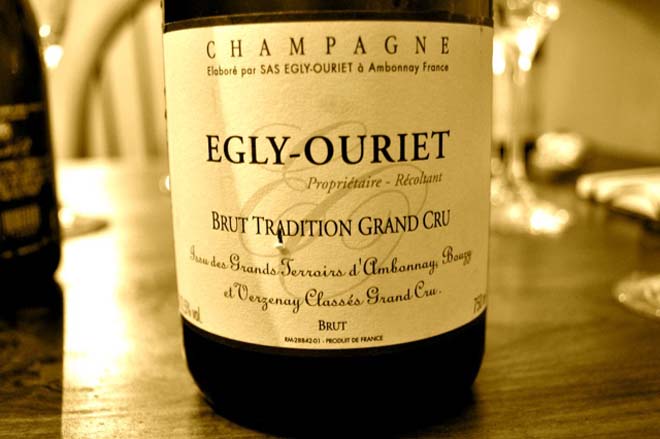Champagne, New Years Eve
Posted on December 21, 2011
by Joe Ricchio
Champagne.
For most Americans, it is an integral part of the celebration ritual, a symbol of luxury and success. The sound of corks popping conjures up images of triumphant professional athletes drenching locker rooms in geysers of bubbly, or Richard Gere’s absurd and untrue suggestion in the film Pretty Woman that strawberries “really bring out the flavor of the Champagne.”
There is tremendous brand loyalty to big-name producers, such as Moët et Chandon, Veuve Clicquot, and Perrier Jouët, that rivals the fanaticism many beer-drinkers display for Miller Lite or Budweiser. For most, the primary indication that one has “made it” in the world is a never-ending river of Dom Perignon or Louis Roederer “Cristal,” flowing freely at a lavish pool party somewhere in Miami.
This association with the act of celebration can sometimes lead us to forget that Champagne is actually the most food-pairing friendly wine in existence, with a range of styles and flavors available. We seem to put so much emphasis on the nuances of a Rhone Valley Syrah to pair up with lamb, for instance, but when it comes to Champagne often simply resort to a brand that is familiar without any consideration for what is actually in the bottle.
Maybe it’s because we don’t actually know a whole lot about Champagne, outside of its role in any special occasion.
Champagne houses generally fall into two categories: Négociant and grower. Négociants purchase grapes to make wine, whereas growers, usually much smaller in size, make wines with fruit from their own estate vineyards. There are an increasing number of grower producers becoming available in the United States, due largely to the efforts of importer and Champagne guru, Terry Theise, who affectionately refers to these wines as “farmer fizz.”
What really opened my eyes to the world of grower producers was a recent visit to the small town of Aÿ in Champagne. While walking through the vineyards with Jean- Baptiste Geoffroy, winemaker for René Geoffroy, he explains to me the nuances of his favorite vintages, such as 1990, and about how many of his wines from these years actually benefit from being decanted. In his ancient cellars I observe a sea of bottles resting calmly for the appropriate amount of time before being released to the world.
The next day I visit the home of Didier Gimmonet, who is the winemaker for Pierre Gimmonet et Fils. We sit for several hours, tasting each of his offerings while discussing the “expression” of his wines, which he creates primarily with Chardonnay, and the right time to pick the grapes before they become too ripe. The wines we drink have incredible depth and minerality and truly showcase the grapes and the vineyards. I am left speechless.
These wineries are tiny in comparison to the multitude of big name houses owned by the Louis Vuitton Moët Hennessey group, and are making a product that embraces the concept of terroir, the French term that refers to wines that taste like “where they come from.” To illustrate this point, René Geoffroy releases about 10,000 cases annually, compared to Moët et Chandon’s 2,000,000.
If you would like to taste this style of bubbly for yourself, these selections are all quite unique, making them great ones to start with:
Pierre Gimmonet et Fils 1er Cru Brut N.V. ($55)
Very creamy in texture, with notes of white flowers, apples, and lemon, it is an excellent
example of what Blanc de Blancs (100 percent Chardonnay) Champagne should taste
like.
René Geoffroy Rosé de Saignée Brut N.V. ($65)
A beautiful rosé that is aggressively flavorful with notes of brioche and fresh
strawberries. While in Champagne, I simply enjoyed a bottle of this and a Prilosec for
dinner one night..
Egly-Ouriet Brut Tradition Grand Cru N.V. ($95)
A full-bodied, nuanced offering with mouthwatering acidity and a finish that seemingly
lingers forever. Winemaker Francis Egly is among those responsible for putting farmer
fizz on the map in the first place.
Baudouin Brut Prestige N.V. ($42)
Made from 100 percent Pinot Noir, displaying pronounced notes of citrus and tropical
fruits, with a comforting, toasty quality to it. You can spend a lot more for a bottle not
nearly as good.
You can find or order each of these at the following Maine retailers, among others:
Browne Trading Market | 262 Commercial St. | Portland | 207.775.7560
Rosemont Market + Bakery | 580 Brighton Ave. | Portland | 207.774.8129
Blue Hill Wine Shop | 123 Main St. | Blue Hill | 207.374.2161
Freeport Cheese + Wine | 178 Lower Main St. | Freeport | 207.869.4048
Rayr | 67 Pascal Ave. | Rockport | 207.230.7009
Sawyer’s Specialties | 353 Main St. | Southwest Harbor | 207.244.3317
State Street Wine Cellar | 195 State St. | Bangor | 207.262.9500








